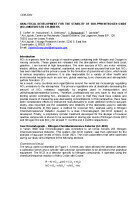Air Monitoring
ANALYTICAL DEVELOPMENT FOR THE STABILITY OF SUB-PPM NITROGEN OXIDE (NOX) MIXTURES IN CYLINDERS
Oct 06 2014
Author: E. Coffre, M. Haouchine, A. Grimberg, V. Bossoutrot, T. Jacksier on behalf of CEM
Introduction
NOX is a generic term for a group of reactive gases containing both Nitrogen and Oxygen in varying amounts. These gases are released into the atmosphere when fossil fuels (coal, gasoline…) are burned at high temperature. The main sources of NOX are motor vehicles, electric utilities, and other industrial, residential, and commercial sources that burn fuel. NOX has been identified as the primary cause for the formation of ground-level ozone, which leads to serious respiratory problems. It is also responsible for a variety of other health and environmental hazards such as acid rain, global warming, toxic chemicals and atmospheric particle formation. (1)
As a result, many countries and organizations around the world are increasingly regulating NOX emissions to the atmosphere. The primary regulations aim at drastically decreasing the amount of NOX released, especially by engines used in transportation and utility/industrial/residential boilers. Therefore, professionals not only have to find ways of limiting and/or controlling NOX emissions, but prior to that they must have reliable and precise means of measuring ever-decreasing concentrations. In this perspective, there have been considerable efforts by instrument manufacturers to lower detection limits to sub-ppm levels. Also important are the availability and reliability of the standards used to calibrate those instruments. In this paper, a method for low-level NOX analysis using a Nitrogen Chemiluminescence Detector coupled to a Gas Chromatograph (GC-NCD system) is developed. Finally, a proprietary cylinder treatment developed for the storage of low-level reactive compounds is shown to be successful in storing ppb levels of Nitrogen Oxide (NO) and Nitrogen Dioxide (NO2) for at least 11 months and 4 months respectively.
Digital Edition
AET 28.2 April/May 2024
May 2024
Business News - Teledyne Marine expands with the acquisition of Valeport - Signal partners with gas analysis experts in Korea Air Monitoring - Continuous Fine Particulate Emission Monitor...
View all digital editions
Events
Jul 30 2024 Jakarta, Indonesia
China Energy Summit & Exhibition
Jul 31 2024 Beijing, China
2024 Beijing International Coal & Mining Exhibition
Aug 07 2024 Beijing, China
IWA World Water Congress & Exhibition
Aug 11 2024 Toronto, Canada
Aug 25 2024 Stockholm, Sweden and online






.jpg)








